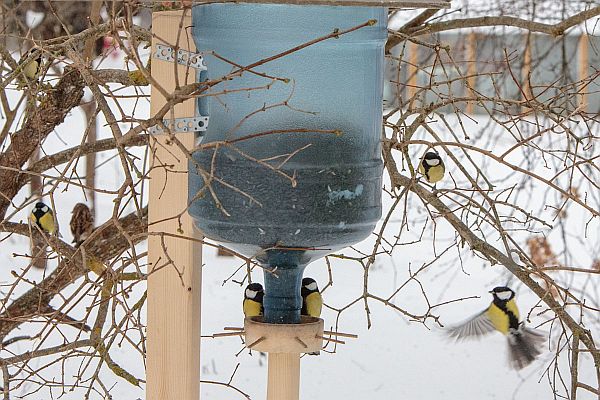Science news for the Year of teh Great Tit edited by UT Bird ecology researcher Marko Mägi,marko.magi@ut.ee
Photo Arne Ader
Translation Liis
Despite the fact that it is easier for birds acting together in a group to notice dangers and sound warning calls they too must keep eyes and ears open at foraging to become aware of an approaching threat. Such a mode of foraging is characteristic for many birds feeding in groups. But what happens when warning calls do not reach their aim? For instance in a noisy environment where the efficiency of warning calls is small or one’s mates do not even perceive the calls. Today humans are ever more accompanied by artificial sounds, particularly in cities where traffic noise is several times louder than the natural background of sound. Yet many birds prefer to breed, winter, forage in cities – is then the noise no problem for them?
In a recent investigation Spanish scientists focused on the connections between noise and the foraging behaviour of birds at the airport of Madrid. The latter is representative of one of the noisiest artificial environments, often close to settlements or even in them. From a scientific point of view using an airport as a model system is a good choice since the birds, used to noise, are not scared by loud sounds and tolerate even the loud noises of the steel birds. On average aeroplanes take off or land in the Madrid airport every 2-5 minutes, causing noise above 76,8 dB.
Feeders were installed in the forest near the airport where the basic enemies of the passerines were sparrowhawks, and the behaviour of great tits was recorded. Researchers already knew that in order to avoid the noise from the air traffic birds started singing earlier in the morning.

In cities feeders should rather be placed on the courtyard side of houses where the traffic noise is less and birds may notice an approaching predator earlier
Theoretically visual signs should be trusted more in a noisy environment because their propagation is not influenced by noise. Since the noise from engines is particularly loud on taking off and landing great tits should be more vigilant and monitor their environment more carefully then rather than in the quieter moments when aeroplanes pass.
And truly – on comparing the time used for eating and keeping watch it turned out that depending on the volume of noise birds were more vigilant or foraged more. In the moments of peak noise the birds were significantly more vigilant than at other moments. While 20 seconds before and after the passing of an aeroplane the great tits used an almost equal amount of time on feeding and on monitoring the environment then at the peak moment of maximum noise the birds were feeding significantly less often and were twice as long in the vigilant state.
Thus it can be presumed that in a noisy environment birds do have to choose between eating and being eaten. Considering this feeders for birds in cities should rather be placed in the courtyard sides of a house where the street noise is not as great and it is easier for birds to notice an approaching predator.
Klett-Mingo JI, Pavón I, Gil D, 2016. Great tits, Parus major, increase vigilance time and reduce feeding effort during peaks of aircraft noise. Animal Behaviour 115: 29-34. doi:10.1016/j.anbehav.2016.02.021


